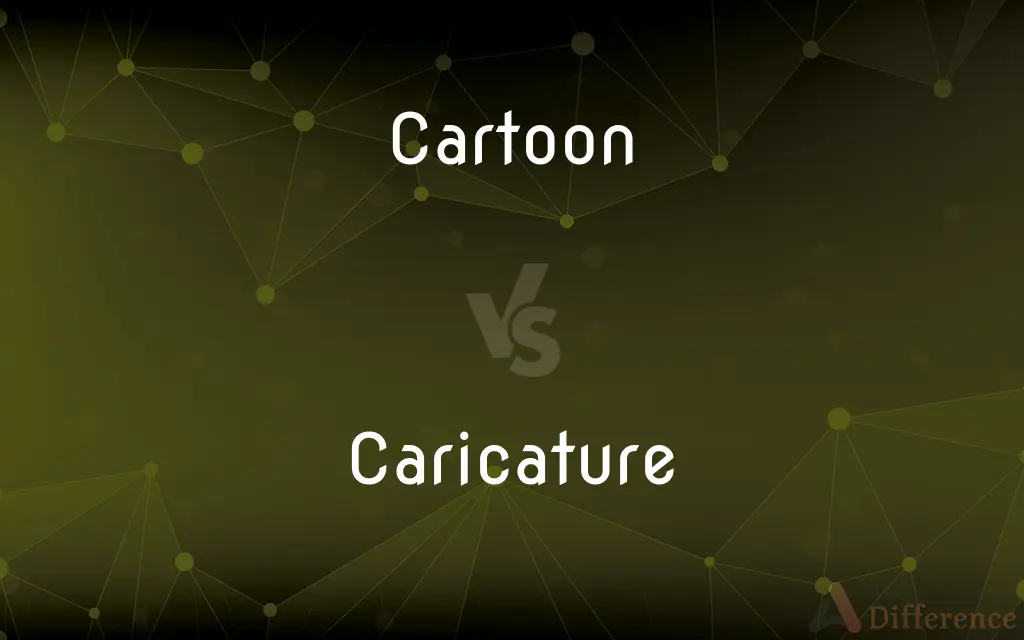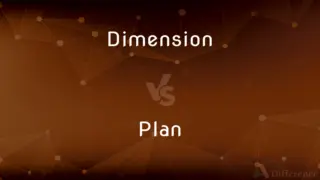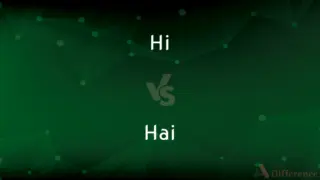Cartoon vs. Caricature — What's the Difference?
By Tayyaba Rehman — Updated on September 28, 2023
Cartoon is a humorous or satirical drawing or animated piece, while caricature is an exaggerated depiction of a person's features or traits for comic effect.

Difference Between Cartoon and Caricature
Table of Contents
ADVERTISEMENT
Key Differences
Cartoons and caricatures are visual art forms used to convey humor, satire, or commentary, albeit in different manners. A cartoon is a drawing, typically in a non-realistic or semi-realistic style, that represents characters and conveys a narrative or a humorous message. It could be a single-frame illustration or a multiframed animation, effectively used to communicate both light-hearted and serious themes. Cartoons are versatile, being instrumental in comic strips, animated shows, political satire, and educational materials, and have the capacity to appeal to diverse audiences through their accessibility and visual narrative.
On the other hand, a caricature is a representation in which the subject's distinctive features or peculiarities are deliberately exaggerated to produce a comic or grotesque effect. Caricatures are often used to satirize or lampoon public figures, accentuating distinct physical traits or characteristics to convey a critical or humorous message. They are predominantly static, single-frame illustrations that spotlight an individual's unique aspects, often providing insightful or comedic commentary on the subject's personality, behavior, or appearance.
While both cartoons and caricatures employ exaggeration and humor, they differ significantly in focus and application. Cartoons are multifaceted, narrating a story or conveying a message through characters and scenes, whereas caricatures zero in on an individual, exaggerating particular features for comedic or critical reflection. Cartoons can be dynamic, evolving through multiple frames or animations, while caricatures are typically static, focusing on portraying an individual in a single illustrative snapshot.
Cartoons and caricatures have been integral in shaping public opinion, offering commentary, and providing entertainment throughout history. They operate at the intersection of art and communication, enabling the expression of thoughts, ideas, and critiques in a visual and engaging manner. Understanding the nuanced differences between cartoons and caricatures aids in appreciating the varied and impactful ways they contribute to visual art, communication, and social commentary.
Comparison Chart
Focus
Conveys a narrative or a humorous message through characters and scenes.
Exaggerates distinctive features of a person for comic or grotesque effect.
ADVERTISEMENT
Application
Can be used in comic strips, animated shows, political satire, and educational materials.
Predominantly used to satirize or lampoon public figures.
Representation
Typically in a non-realistic or semi-realistic style.
Deliberate exaggeration of peculiarities.
Dynamics
Can be single-frame or multiframed, static or animated.
Typically static, single-frame illustrations.
Range
Wide-ranging, versatile in themes and representation.
Primarily focused on individuals and their exaggerated traits.
Compare with Definitions
Cartoon
A drawing representing characters in a humorous or satirical scenario.
The political cartoon highlighted the government's inefficiency subtly.
Caricature
A satirical illustration highlighting an individual's peculiarities.
The caricature exaggerated the athlete's muscular build to comedic effect.
Cartoon
An animated piece illustrating a story or concept, often humorous.
The cartoon entertained children while imparting moral values.
Caricature
An exaggerated depiction of a person's distinctive features or traits.
The caricature emphasized the politician's prominent nose and ears.
Cartoon
A visual narrative in a non-realistic or semi-realistic style.
The cartoon depicted the complexities of modern life in a relatable manner.
Caricature
A static visual art form used for comic or grotesque portrayal.
The artist's caricature of the celebrity was a hit at the exhibition.
Cartoon
A versatile medium used in comic strips, animation, and political satire.
The newspaper's cartoon section provided a comedic take on current events.
Caricature
A representation lampooning public figures by accentuating unique aspects.
The caricature drew laughs for its humorous take on the actor's distinct style.
Cartoon
A cartoon is a type of illustration that is typically drawn, sometimes animated, in an unrealistic or semi-realistic style. The specific meaning has evolved over time, but the modern usage usually refers to either: an image or series of images intended for satire, caricature, or humor; or a motion picture that relies on a sequence of illustrations for its animation.
Caricature
A medium offering insightful or comedic commentary on a subject's appearance or behavior.
The caricature cleverly spotlighted the musician's flamboyant personality.
Cartoon
A drawing depicting a humorous situation, often accompanied by a caption.
Caricature
A caricature is a rendered image showing the features of its subject in a simplified or exaggerated way through sketching, pencil strokes, or through other artistic drawings (compare to: cartoon). Caricatures can be insulting or complimentary and can serve a political purpose or be drawn solely for entertainment.
Cartoon
A drawing representing current public figures or issues symbolically and often satirically
A political cartoon.
Caricature
A representation, especially pictorial or literary, in which the subject's distinctive features or peculiarities are deliberately exaggerated to produce a comic or grotesque effect.
Cartoon
A preliminary sketch similar in size to the work, such as a fresco, that is to be copied from it.
Caricature
The art of creating such representations.
Cartoon
A usually short, animated movie or television program.
Caricature
A grotesque imitation or misrepresentation:The trial was a caricature of justice.
Cartoon
An animated character in a movie or television program.
Caricature
To represent or imitate in an exaggerated, distorted manner.
Cartoon
A comic strip.
Caricature
A pictorial representation of someone in which distinguishing features are exaggerated for comic effect.
Cartoon
A ridiculously oversimplified or stereotypical representation
Criticized the actor's portrayal of Jefferson as a historically inaccurate cartoon.
Caricature
A grotesque misrepresentation.
Cartoon
To draw a humorous or satirical representation of; caricature.
Caricature
(computing) In facial recognition systems, a face that has been modified to look less like the average face, and thus more distinctive.
Cartoon
To make humorous or satirical drawings.
Caricature
Having the characteristics of a caricature, grotesque.
Cartoon
(comics) A humorous drawing, often with a caption, or a strip of such drawings.
Caricature
To represent someone in an exaggerated or distorted manner.
Cartoon
(comics) A drawing satirising current public figures.
Caricature
An exaggeration, or distortion by exaggeration, of parts or characteristics, as in a picture.
Cartoon
(arts) An artist's preliminary sketch.
Caricature
A picture or other figure or description in which the peculiarities of a person or thing are so exaggerated as to appear ridiculous; a burlesque; a parody.
The truest likeness of the prince of French literature will be the one that has most of the look of a caricature.
A grotesque caricature of virtue.
Cartoon
(arts) A full-sized drawing that serves as the template for a fresco, a tapestry, etc.
Caricature
To make or draw a caricature of; to represent with ridiculous exaggeration; to burlesque.
He could draw an ill face, or caricature a good one, with a masterly hand.
Cartoon
(animation) An animated piece of film which is often but not exclusively humorous.
Caricature
A representation of a person that is exaggerated for comic effect
Cartoon
A diagram in a scientific concept.
Caricature
Represent in or produce a caricature of;
The drawing caricatured the President
Cartoon
To draw a cartoon, a humorous drawing.
Cartoon
(arts) To make a preliminary sketch.
Cartoon
A design or study drawn of the full size, to serve as a model for transferring or copying; - used in the making of mosaics, tapestries, fresco pantings and the like; as, the cartoons of Raphael.
Cartoon
A large pictorial sketch, as in a journal or magazine; esp. a pictorial caricature; as, the cartoons of "Puck."
Cartoon
Same as comic strip.
Cartoon
A motion picture consisting of a series of frames, each being a photograph of a drawing rather than a frame produced by filming a scene of true action, and in which the objects are displaced slightly in succeeding frames so as to give the appearance of motion when projected as a motion picture on the screen. The types of characters portrayed in such films are often similar or identical to those in a comic strip.
Cartoon
A humorous or satirical drawing published in a newspaper or magazine
Cartoon
A film made by photographing a series of cartoon drawings to give the illusion of movement when projected in rapid sequence
Cartoon
Draw cartoons of
Cartoon
A simplistic, exaggerated representation used for comedic or educational purposes.
The science cartoon made learning fun and accessible for students.
Common Curiosities
Where are cartoons commonly found?
Cartoons are often found in newspapers, magazines, comic strips, and animated shows.
What is a cartoon?
A cartoon is a simplified, often humorous illustration or animation, commonly used for satire, caricature, or comic effect.
Are all cartoons meant to be funny?
No, while many cartoons are humorous, others can be serious or educational.
What is the main purpose of a caricature?
The primary purpose of a caricature is to highlight and exaggerate specific features or traits of a person for humorous or satirical effect.
Do cartoons always have captions?
No, while many cartoons come with captions, others rely solely on the imagery to convey a message or joke.
Who creates caricatures?
Caricatures are usually created by artists who specialize in capturing and exaggerating the distinct features of their subjects.
Are cartoons a modern art form?
While cartoons are prevalent in modern media, their origins date back centuries, with historical versions found in ancient cultures.
Are caricatures limited to human subjects?
Primarily, caricatures depict humans, but artists can also caricature animals, objects, or abstract concepts.
How does a caricature differ from a cartoon?
A caricature is a depiction in which certain features or characteristics of the subject are exaggerated for comic or satirical effect, while a cartoon can address broader subjects, not necessarily limited to character depictions.
Can a cartoon be a caricature and vice versa?
Yes, a cartoon can include caricatured characters, and a caricature can be presented in cartoon format.
Can caricatures be considered offensive?
Yes, depending on the exaggeration and the intent behind the depiction, caricatures can sometimes be perceived as offensive.
Is a political cartoon a type of caricature?
Often, yes. Political cartoons frequently use caricature to satirize public figures.
Can cartoons be animated?
Yes, cartoons can be static illustrations or animated sequences, as seen in TV shows and films.
Why are caricatures popular at events and fairs?
Caricatures offer a fun and quick way for attendees to get a personalized and humorous rendition of themselves.
What tools do artists use for creating cartoons?
Artists can use pencils, inks, digital tools, or various other mediums to create cartoons.
Share Your Discovery

Previous Comparison
Dimension vs. Plan
Next Comparison
Hi vs. HaiAuthor Spotlight
Written by
Tayyaba RehmanTayyaba Rehman is a distinguished writer, currently serving as a primary contributor to askdifference.com. As a researcher in semantics and etymology, Tayyaba's passion for the complexity of languages and their distinctions has found a perfect home on the platform. Tayyaba delves into the intricacies of language, distinguishing between commonly confused words and phrases, thereby providing clarity for readers worldwide.














































